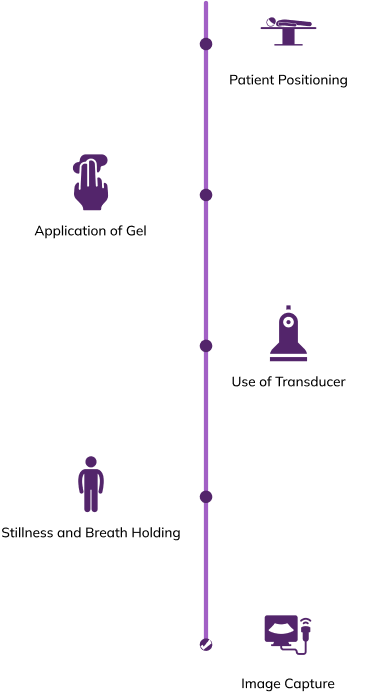
We use the latest ultrasound equipment to ensure the highest quality images for precise diagnoses.

Our experienced doctors and sonographers interpret the ultrasound results with great accuracy

Your well-being is our priority, and we ensure a comfortable and stress-free experience during the ultrasound examination.







A pelvic ultrasound examines the organs in the pelvic area between the lower abdomen (belly) and legs. It assesses organs such as the bladder, prostate, rectum, ovaries, uterus, and vagina. Consider an Ultrasound Scan In Bangalore for a comprehensive examination of your pelvic organs.
For pelvic ultrasounds, you may be required to fill your bladder by drinking water before the test. A full bladder can provide better visualization of the pelvic organs. Your healthcare provider will give you specific instructions on how much water to drink and when to do so before the ultrasound.
For abdominal ultrasounds, you may need to adjust your diet or fast for several hours before the test. Fasting typically involves not eating or drinking anything except water for a specific period to ensure clearer images of the abdominal organs. It’s essential to follow your healthcare provider’s instructions carefully to ensure the accuracy of the ultrasound results.
I was thoroughly impressed with my thyroid ultrasound here. The staff was friendly, the technician skilled, and results were promptly provided with clear explanations
Koshikaa for breast ultrasounds surpassed my expectations. The staff was professional and caring, the technician thorough, and the facility clean and comfortable. Highly recommended.
My pelvic ultrasound experience here was seamless. The knowledgeable technician answered all my questions, and results were promptly delivered with follow up to ensure understanding.


Ultrasound can effectively visualize various structures and conditions within the body like –
USG is particularly valuable for examining soft tissue diseases that may not be clearly visible on X-rays. It is also useful for distinguishing between fluid-filled cysts and solid tumours due to their different echo patterns. Furthermore, ultrasound is a preferred imaging option in certain situations because it is quick and does not expose patients to radiation.
Your healthcare provider may recommend an ultrasound to gain more insight into the cause of various symptoms, such as unexplained pain, masses (lumps), or abnormal blood test results.
Additionally, ultrasound is often more cost-effective compared to other imaging tests, making it a favourable choice for medical evaluations.
Preparation for ultrasonography can vary depending on the specific body part being scanned. Here are some common preparations for ultrasound scan in bangalore –
Ultrasound can easily detect cancer, especially in soft tissues. It is often used as the initial step in the cancer diagnostic process. Ultrasound offers several advantages, such as being a quick and cost-effective test that doesn’t expose the patient to radiation.
It plays a crucial role in cancer detection and assessment. It can help identify suspicious areas in soft tissues that may require further evaluation, guiding the healthcare provider in determining the most appropriate course of action for the patient.
NOTE: Ultrasound images may not have the same level of clarity or detail as those obtained from CT or MRI scans. Therefore, it may not be sufficient to confirm a cancer diagnosis on its own. In many cases, further imaging or additional tests, such as biopsies, are needed to make a definitive cancer diagnosis.
NOTE: In some instances, ultrasound scan in bangalore may be used in combination with other imaging tests to provide a comprehensive evaluation of suspected cancerous areas.
An ultrasound procedure usually takes around 20 to 30 minutes to complete. However, the actual duration can vary depending on the type of examination being performed and the complexity of finding any changes or abnormalities in the organs being studied.
